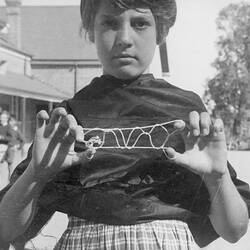Summary
Alternative Name(s): Whirligig
Made: Alan Waters, delegate to the World Play Summit, Melbourne, 1993., 1992
Designed and donated by Alan Waters in 1992. Mr. Waters was a delegate to the World Play Summit held in Melbourne in 1993. Delegates were asked to bring a traditional toy from their own country.
The Australian Children's Folklore Collection is unique in Australia, documenting contemporary children's folklore across Australia and in other countries reaching back to the 1870s. The Collection has a strong component of research material relating to Victoria.
This paper windmill is a variation on the genre of children's toys that use wind to create noise (such as wirling, humming or percussion toys) or movement (such as kites, paper aeroplanes or paper windmills). Part of the appeal of these toys is in using the imagination to create a design that will make the best use of natural energy sources. This paper windmill is also handmade. Throughout the world, children play with toys and other playthings which have been handmade by themselves or adults, for their amusement. These types of toys are often created from readily obtained materials like pieces of wood, wire, cloth, paper or other recycled packaging materials. Windmills have been popular children's toys at least since medieval times.
Physical Description
Paper windmill or whirligig, consisting of a handle made from a piece of dark dowel with a wooden bead fitted on the top end. A hole has been drilled through the side of the bead and another piece of narrower dowel fits at right angles to the handle. This has the paper windmill attached between two yellow wooden beads. The windmill is shaped like angel's wings and is cut from heavy red cardboard and glued to a round plastic washer to give it it's shape. Wind, or the action of blowing on the windmill, causes the angel's wings to spin around. Acknowledgement: Australian Children's Folklore Collection, Museum Victoria.
More Information
-
Collection Names
-
Collecting Areas
-
Acquisition Information
Cultural Gifts Donation from Dr June Factor, 18 May 1999
-
Acknowledgement
Donated through the Australian Government's Cultural Gifts Program.
-
Maker
Mr Alan Waters, Melbourne, Greater Melbourne, Victoria, Australia, 1992
-
Classification
-
Category
-
Discipline
-
Type of item
-
overall dimensions
17 cm (Length), 7 cm (Width), 32 cm (Height)
-
References
Stanbury, P & Bushell, L. 'Toys to Remember', 1987.
-
Keywords
Children's Play, Handmade Games & Toys, Paper Craft, Toys, Wind, World Play Summit, 1993, Making History - Australian Childrens Folklore
